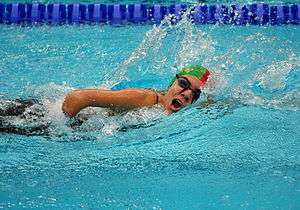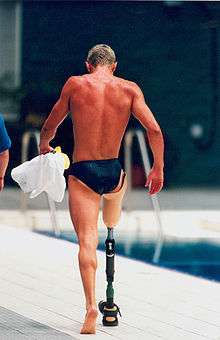Paralympic swimming

Paralympic swimming is an adaptation of the sport of swimming for athletes with disabilities. Paralympic swimming is contested not only at the Summer Paralympic Games, but at disabled sports competitions throughout the world. The sport is governed by the International Paralympic Committee, hence the name of "Paralympic" swimming.
Rules for the sport are adapted from those set forth by the International Swimming Federation (FINA). Swimmers compete individually in backstroke, breaststroke, butterfly, freestyle, individual medley, and as teams in relay races. At the Paralympics, World Championships and other elite level competitions, swimmers compete in an Olympic-size swimming pool.
Significant differences between able-bodied and Paralympic swimming include the starting position and adaptations allowed for visually impaired swimmers. Competitors may start a race by standing on a platform and diving into the pool, as in non-disabled swimming, or by sitting on the platform and diving in, or they may start the race in the water. In events for the blind and visually impaired, people called "tappers" may stand at the end of the pool and use a pole to tap the swimmers when they approach the wall, indicating when the swimmer should turn or end the race. [1]
Classification

Swimmers are classified according to the type and extent of their disability. The classification system allows swimmers to compete against others with a similar level of function.
Swimmers with physical disabilities are allocated a category between 1 and 10, with 1 corresponding to the most severe types of disability. Physical disabilities of Paralympic swimmers include single or multiple limb loss (through birth defects and/or amputation), cerebral palsy, spinal cord injuries (leading to paralysis or disability in limb coordination), dwarfism, and disabilities which impair the use of joints.[2]
Blind and visually impaired swimmers compete within separate categories, being allocated to categories 11, 12 or 13. Category 11 corresponds to totally blind swimmers, while competitors in category 13 have severe but not total visual impairment.[2] Category 11 swimmers compete with blackened goggles to ensure competitors are on an even level. Category 11 swimmers are also required to use tappers but they are optional for category 12 and 13. [3]
Swimmers with mental disabilities compete in category 14.[2]
Numbers are combined with a letter prefix depending on the event type. An "S" prefix corresponds to freestyle, backstroke and butterfly, while "SB" corresponds to breaststroke and "SM" to the medley. Hence, a swimmer with severe physical disabilities competing in backstroke may compete in an S3 event, while a blind swimmer in the medley would compete in class SM11.[2]
For relay races, athletes from different classifications compete together, but the sum of their individual classifications must not exceed a given points total. For example, a relay team for a 34 points freestyle relay may consist of two S8 swimmers and two S9 swimmers (9 + 9 + 8 + 8 = 34), or an S10 swimmer and three S8 swimmers (10 + 8 + 8 + 8 = 34)
See also
- World Disabled Swimmers of the Year
- Category:World record holders in paralympic swimming
- Disability sport classification
References
- ↑ "Swimming - About the sport". International Paralympic Committee. 2008. Retrieved 2008-09-14.
- 1 2 3 4 "A-Z of Paralympic classification". BBC. 2008-08-28. Retrieved 2010-01-03.
- ↑ https://m.paralympic.org/swimming/classification